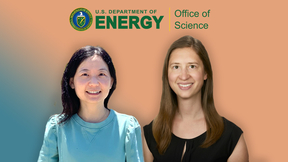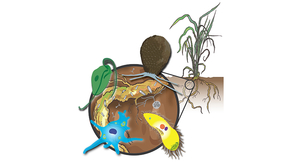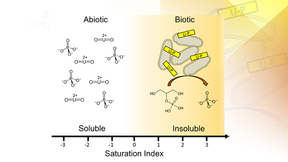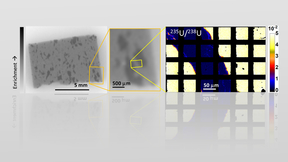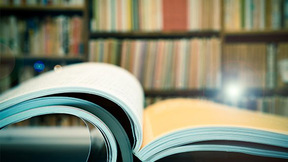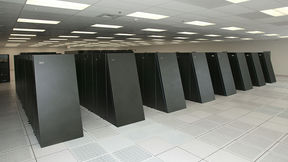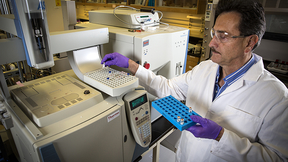Back
Just a few bacterial groups found in ecosystems across the planet are responsible for more than half of carbon cycling in soils, according to new findings from researchers at Lawrence Livermore National Laboratory (LLNL) and Northern Arizona University, published in Nature Communications. The new research suggests that despite the diversity of microbial taxa found in wild…
Two scientists from Lawrence Livermore National Laboratory (LLNL) are recipients of the 2021 Department of Energy’s (DOE) Office of Science Early Career Research Program award. Andrea Schmidt and Xue Zheng are among 83 scientists nationwide selected for the recognition. Under the program, typical awards for DOE national laboratory staff are $500,000 per year for five years…
Plants evolved in a world dominated by prokaryotic and eukaryotic microbes. Underneath the surface, plant roots interact with microbes in the soil, also called the rhizosphere microbiome. Although bacteria and fungi are well-studied in the rhizosphere (the layer closest to the roots), other components, including viruses and protists, are less well known. A protist is any…
Uranium contamination of soils and groundwater in the United States represents a significant health risk and will require multiple remediation approaches. Remediation strategies for uranium-contaminated sites have been the focus of research for decades due to the former production of nuclear materials across the United States. The U.S. Environmental Protection Agency (EPA)…
Penn State graduate student Joseph Mattocks has been selected to serve at Lawrence Livermore National Laboratory as part of the Department of Energy’s (DOE) Office of Science Graduate Student Research (SCGSR) Program. Mattocks will serve in LLNL's Nuclear and Chemical Sciences Division. “I feel both honored and grateful to have been given this opportunity to pursue a…
In inertial confinement fusion (ICF) experiments at the National Ignition Facility (NIF), a spherical shell of deuterium-tritium fuel is imploded in an attempt to reach the conditions needed for fusion, self-heating and eventual ignition. Since theory and simulations indicate that ignition efficacy in one-dimension (1D) improves with increasing imploded fuel convergence…
“Sterile neutrinos” are theoretically predicted new particles that offer an intriguing possibility in the quest for understanding the dark matter in our universe. Unlike the known “active” neutrinos in the Standard Model (SM) of particle physics, these sterile neutrinos do not interact with normal matter as they move through space, making them very difficult to detect. A…
Three Lawrence Livermore National Laboratory (LLNL) postdoctoral appointees have been selected to attend the 70th annual Lindau Nobel Laureate meeting in Germany this June thanks to the University of California President’s 2021 Lindau Nobel Laureate Meetings Fellows Program. The three selected to attend the meeting are Oluwatomi (Tomi) Akindele, Matthew Edwards and Wei Jia…
Researchers from Lawrence Livermore National Laboratory (LLNL) and their colleagues who help them commercialize technologies have won three national technology transfer awards this year. The trio of awards, from the Federal Laboratory Consortium (FLC), represent the most national awards that LLNL has ever won in one year’s competition over the past 36 years. Two of the…
Elevated carbon dioxide emissions from human activities increase the uptake of carbon by plants but may decrease storage in soil. An international team led by Lawrence Livermore National Laboratory (LLNL) scientists synthesized 108 elevated carbon dioxide (CO2) experiments in various ecosystems to find out how much carbon is absorbed by plants and soil. The research…
What are the next world-class, game-changing concepts and technologies that will address the most important questions in astrophysics or planetary science? Lawrence Livermore National Laboratory (LLNL) researchers will soon be better equipped to answer this question with the launch this month of a new Space Science Institute (SSI), intended to boost cross-discipline…
Lawrence Livermore National Laboratory (LLNL) employees, participating in 10 project teams, recently earned Department of Energy (DOE) Secretary Achievement Awards. Representing some of the highest internal, non-monetary recognition that DOE employees and contractors can receive, these awards recognize DOE employees and contractors for their service and contributions to…
As the solar system was developing, the giant planets (Jupiter and Saturn) formed very early, and as they grew, they migrated both closer to and further away from the sun to stay in gravitationally stable orbits. The gravitational effect of these massive objects caused immense reshuffling of other planetary bodies that were forming at the time, meaning that the current…
When it comes to the semiconductor industry, silicon has reigned as king in the electronics field, but it is coming to the end of its physical limits. To more effectively power the electrical grid, locomotives and even electric cars, Lawrence Livermore National Laboratory (LLNL) scientists are turning to diamond as an ultra-wide bandgap semiconductor. Diamond has been…
Lawrence Livermore National Laboratory (LLNL) scientists received mock evidence, consisting of two uranium oxide (UO2) fuel pellets, as part of an international nuclear forensic exercise in support of a simulated nuclear smuggling investigation. The exercise was part of the CMX-5 Collaborative Materials Exercise organized by the Nuclear Forensics International Technical…
Fifty-seven researchers from Lawrence Livermore National Laboratory (LLNL) were among the top 2 percent of the most cited researchers worldwide throughout their careers, according to research on metascience by Stanford University. Metascience is the "study of studies" using scientific methods. Stanford University professor John Loannidis worked alongside U.S.-based Kevin…
Growing up in Lima, Peru, Livermore chemist Carlos Valdez excelled in art and soccer. But his first love was science.
A team of current and former Lawrence Livermore National Laboratory (LLNL) and IBM scientists won the annual “Test of Time” award at the 2020 Supercomputing Conference on Nov. 19 for a paper outlining LLNL’s Blue Gene/L supercomputer. Published by the Supercomputing Conference in 2002, the paper was the first peer-reviewed overview article to disclose details of Blue Gene…
The Forensic Science Center is an important ally in the international endeavor to prohibit chemical warfare agents.
A long time ago — roughly 4.5 billion years — our sun and solar system formed over the short time span of 200,000 years. That is the conclusion of a group of Lawrence Livermore National Laboratory (LLNL) scientists after looking at isotopes of the element molybdenum found on meteorites. The material that makes up the sun and the rest of the solar system came from the…


